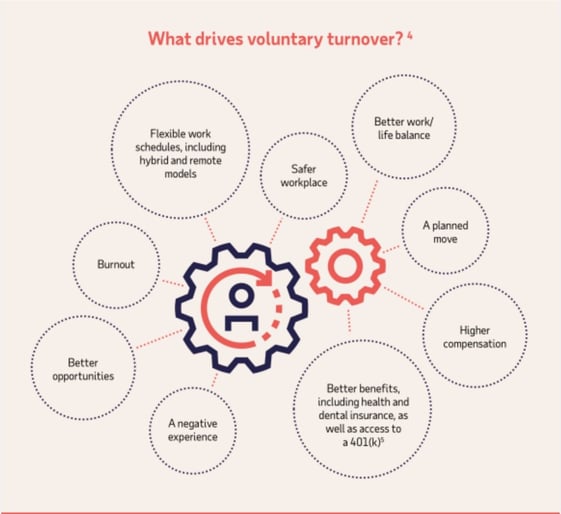It’s a tough time for hiring and retaining employees. So many factors contribute to this but at the end of the day, positions need to be filled and it has been a struggle for a lot of employers to keep up with turnover and an ever present need to find the right candidates. In a recent Twitter chat for USA Manufacturing Hour, participants discussed this very topic, led by host, Tami Matthews and Ruth Johnson from Lane Supply in Colorado.
Employee Retention and Reasons Employees Leave
The chat kicked off with a discussion about what the challenges are in retaining employees and why employees are leaving. This is a topic that everyone participating had a lot of opinions about.
Dan Bigger from Optessa Inc in NJ said, “I left because I couldn't work from home and the company that I worked for, just didn't get it.”
Lane Supply Company said, “Flexible work schedules are a big deal ... especially now that people have been working from home for two years.”
Gina M. Tabasso from MAGNET in Ohio said, “To pursue other jobs or get more money/experience, also people retiring.”
Matt Long from Aviate Creative in NJ said, “The challenges I've noticed usually relate to workplace culture, rate of pay, management style, and rigidity in structure and career progression.”
Nicole Donnelly from Donnelly Marketing Group in Virginia said, “I can speak for my own challenges in staying with a company and what I hear from others. Usually it comes down to future growth opportunities aren't there, micromanagement, lack of autonomy.”
Lane Supply Company said, “Whoa - those are some good challenges.”
Val Weber from Monofrax in New York said, “New employees leave when they realize just how difficult some jobs are. We're a foundry. Some jobs are only for the adventurous.”
Nicole Fiene from Lane Supply in Colorado said, “ADP put out a great resource on identifying why people voluntarily leave their jobs. Here are some of the reasons:”

Lane Supply Company said, “Definitely good resources. SHRM (Society for Human Resource Management) has some good stuff.”
Paulie Rose from RCF Technologies in Missouri said, “When larger companies can pay more than small manufacturing companies for entry level jobs, it’s tough to compete.”
Ruby Rusine from Social Success Marketing in California said, “Work ethic + character are very important to me. I can retain an employee that I can train on tasks but I know I can’t train them on character and work ethic.”
She continued, “Other reasons besides pay+benefits: > not a fit - values, team affinity, low engagement > not challenging enough or too challenging > location > workload > poor working conditions > low morale > feeling they are not valued or appreciated.”
Manufacturers' News, Inc. said, “We haven't had much of an issue with retention (many of our employees have been with us for decades!) However, more people quitting means there's more opportunity out there, and so this is something every employer has to keep an eye out for.”
Lane Supply Company said, “Yes, it's really important for companies to keep an eye on this.”
David Crysler from The Crysler Club in Michigan said, “People leave for good reasons and bad. Good could be to pursue their dream of entrepreneurship. Bad could be your culture. My best advice is if you have a hard time retaining amazing people, and you're in leadership, is to first look in the mirror.”
Emily from Obsidian Manufacturing Industries, Inc. in Illinois said, “We see often times employees are leaving for better opportunities whether it is pay, hours or schedule.”
Ingor van Rooi from Canada said, “I only work with independent contractors, so this isn't applicable to me BUT, the main reason people leave is lack of respect which can manifest in various ways including being underpaid or not having a seat at the table.”
VirtuDesk said, “Hmm. We were not affected by the Great Resignation. In 2021 alone, we experienced 129% employee growth. So, all eyes and ears on this topic.”
Chase Bodor from Plastics Plus Technology in California said, “For the most part it is temporary employees that leave us. Those positions are labor-intensive but are ultimately not much different than running a fast-food line. And those jobs just aren't for everybody.”
Lane Supply Company said, “Hmmm. Sounds like it's time to dig into that some and see if you have enough resources.”
Bodor responded, “Totally! Ultimately, I think it comes down to onboarding and laying out a performance/ growth plan.”
Crysler said, “Having a process is key!”
Nigel T Packer from PelaTis Online in Wales, UK said, “I have quite a few well paid jobs in my time. Reasons: #1 Lack of support from senior management #2 Risk aversion from senior management #3 Failure by senior management to keep promises.”
Erin Courtenay from Earthling Interactive in Wisconsin said, “Tech is competitive for two specific reasons: 1) money and 2) project/work interest. Developers like solving interesting problems and there are lots of cool opportunities out there. Luckily our work culture helps us maintain a very low turnover rate
Lane Supply Company said, “Wonderful.”
 Hosts Matthews and Johnson said, “According to the CNN, 4.4 million Americans quit their jobs last month. Ouch!
Hosts Matthews and Johnson said, “According to the CNN, 4.4 million Americans quit their jobs last month. Ouch!
They continued, “Pay is a factor, but it’s not the only factor. Knowing your turnover rate, conducting exit interviews and monitoring those, and surveying employees on engagement may help you understand whether more employees are thinking of quitting and why.”
Key levers typically include:
- Allowing employees to make decisions (and mistakes)
- Letting employees to do what they love
- Appreciating your workers and ensuring they know you appreciate them
- Giving opportunities to collaborate and socialize with each other
- Providing opportunities to learn, grow, and advance
- Training managers
- Encouraging good communication, including among managers and employees
- Making your company’s mission and objectives clear
- Enlisting employees to help fix company issues
- Understanding your culture and ensuring it matches your values
- Making the workplace as flexible as possible, including offering remote work options if available
They also noted, “One size doesn’t fit all. One employee may have time constraints due to children. Another may yearn to go back to school for something else. Managers should be encouraged to be communicative, open, and creative.”
Nicole Fiene also from Lane Supply in Colorado added, “Benchmark Reports are also super helpful so that an organization can see where they stack up against the rest of their industry in their area as far as turnover. Helps to initiate an internal diagnosis of what might be triggering it.”
Addressing the Reasons Employees Leave
Scary statistic: According to Bloomberg, company culture was 10.4 times more likely to predict employee attrition than compensation, a new study finds.
The discussion continued with participants sharing what they are doing to address the issues that lead to employees leaving.
Bigger said, “Company culture was a big deal in my last job search which was only a month or so ago.”
Lane Supply Company said, “Always a huge factor.”
Long said, “Compensation is just a reward for working effectively in an organization. Culture fit determines how much you enjoy working in that organization. We address these issues in the hiring phase. You can teach technology easier than you can teach character.”
Courtenay said, “There are two levels of culture - both are important, but one is easier to maintain. Activities and perks are easy to implement but the values that run deep under the surface are more important and depend heavily on leadership to maintain.”
Lane Supply Company said, “Yes, leadership is huge. They set the tone and demonstrate the values. Companies need to start there.”
Emily said, “I haven't been with Obsidian long enough to know from their stand point. But personally, enjoying the people you work with is far more important in my opinion then getting paid very well. Besides, you spend 40 hours a week with them.”
Adam Baker from Schooley Mitchell in Pennsylvania said, “We've been helping businesses recover money that was unnecessarily going to their vendors. With that money, some purchased supplemental benefits for their current workforce & others invested in new equipment to make work easier for their workers to help with retention.”
Lane Supply Company said, “Cost reductions to spend in the RIGHT areas make a difference, don't they?”
Donnolly said, “I hired my first employee who starts next week! YAY!!!! She gets an annual education allowance, hours every week for her to spend on training. and she can work from anywhere and choose her own work schedule.”
Rusine said, “Fantastic!”
Bigger said, “Congrats, Nicole.”
Brash Inc in Canada said, “We're a young company (only 5!) but we've lost employees due to moving/life changes. However, the marketer behind this account has left some awful jobs before Brash because of company culture due to dishonest behavior, sexual harassment, gaslighting, micromanaging.”
They continued, “Recommendation on how to fix that: new leadership. If people are mass quitting, saying they don't trust you/the exec team, it's time to walk away and learn how to be better. Even if it's your own business. Your business will fail if you can't keep talent."
Lane Supply Company said, “Culture is really huge and it usually starts w/ leadership.”
Dana Engelbert, a Public Relations expert from Mississippi said, “So true. Culture. Work environment.”
Tabasso said, “Having a KA culture!”
Lane Supply Company said, “Oooo! We like that.”
Crysler said, “Respect your people. Empathize with your people. Be flexible with your people. Actively listen to your people. Celebrate your people. Reward your people. You have no business without people. You cannot succeed without people.”
Fiene said, “There is an awesome engagement tool called 'StandOut'.. it is a self-assessment that leadership& employees can take. It identifies everyone's STRENGTHS so U can cultivate them. It helps foster a really positive company culture where every1 understands each other!”
Lane Supply Company said, “Love it! Strengths Finder is another good one. Employee engagement surveys help HR know what to do/when and how to help.”
 Baker said, “I used to give a copy of my strength finders results to my bosses so they knew how to effectively manage me (significance, belief, restorative, achiever, activator!). It made life easy.”
Baker said, “I used to give a copy of my strength finders results to my bosses so they knew how to effectively manage me (significance, belief, restorative, achiever, activator!). It made life easy.”
Fiene said, “Wow, love this.. taking initiative, that is certainly thinking above board.. awesome!”
Hosts Matthews and Johnson said, “Knowing is always the first step. But it’s not the only step. For some of the levers mentioned in the first answer, you can do other things.”
They shared the following ways to address the issues leading employees to leave a company:
- Create rewards and recognition programs to appreciate co-workers, even enlisting employees to help
- Use emails and newsletters to thank employees
- Start a training program for managers
- Audit communication vehicles and use the ones your employees like best
- Communicate existing education programs or consider creating them
- Communicate expectations, including how often (and how) managers should communicate with their teams such as check-ins, meetings, and “stay interviews”
- Create flexible workplace policies as well as rules or guidelines about how to engage in them or who they’re for
- Provide budget for social outings for departments.
Attracting New Employees
Scary statistic: In February, the number of hires edged up to 6.7 million. Employers, you have a lot of competition.
The discussion then turned to what employers are doing to attract new employees. Participants shared their thoughts.
Bigger said, “No Idea. I know we are looking to add people.”
Donnelly said, “I'm still figuring this out...love seeing everyone's responses to this question.”
Manufacturers' News, Inc. said, “Promoting our company culture has gone a long way for us. Longstanding, family-owned business with long tenure of staff and a friendly, open environment. We get a lot of referrals (even past customers like @KatiMcDermith have come to work with us!)”
Engelbert said, “Long tenure speaks volumes about culture!”
Emily said, “We are connecting through social media especially with the younger generations as well as creating recruitment videos.”
Courtenay said, “We've made employee retention and attraction one of our strategic goals for the year. Our retention activities are an important strategy for recruiting because happy staff are the most effective recruiters.”
Engelbert said, “Really interested in the responses to this. Was researching a blog post recently and saw that Indeed adds 10 MILLION new job openings every minute. I'm curious about what everyone is doing beyond the traditional job posting, recruiting event, etc. “
Rusine said, “My network of friends especially those that know me well. Anyone can talk shop during an interview, or gloss over the resume but nothing like a recommendation coming from people I know.”
Fiene said, “There's been a large influx of biz turning to a #PEO to get access to top notch benefits for their employees because becoming an 'employer of choice' can get VERY pricey! Also unique benefits like helping employees pay back their student loan debt, etc.”
Bigger said, “Us old guys are paid off by now. Can they pay the kids off?”
Tabasso said, “Word of mouth/network, referrals, social media.”
Lane Supply Company said, “YES!!! Word of mouth starts with ... employees.”
Paul Kiesche from Aviate Creative in New Jersey said, “To appeal to applicants we: • Offer a competitive salary • Offer a work-from-home stipend • Share our values and family first policy • Be genuine and honest • Show our culture • Show respect and give credit • Discuss their future path”
Manufacturers' News, Inc. said, “This is great.”
Lane Supply Company said, “Great answers, Paul.”
Kati McDermith in Illinois said, “I try to have as much fun as I can, being as helpful as I can to our customers & audience... then people want to join in!”
Velavu in Canada said, “We're a young startup, but we really value collective decision making, transparency, and empowering our team to lead projects without much oversight, just looping us in as needed. We also have snacks.”
Lane Supply Company said, “Decision-making is big! Transparency is also important. Snacks ... sure! Please tell us you don't have bean bags.”
Brash Inc said, “We just completed an employee survey last week! We consistently hear (even before COVID) that choosing your hours; choosing remote or in office; ability to learn, make mistakes; and autonomy are our top appeals. We also have a lot of sparkling water and snacks.”
Hosts Matthews and Johnson said, “It really starts with your current employees. Word-of-mouth – the best advertising! – can get you great new hires faster. They’ll come in knowing more about the company, have instant friends (the employees who referred them), and even speed up the hiring process.”
They continued, “Of course, social media (LinkedIn and Facebook) can enable your employees to share positions themselves and recommend your company.”
Current Employees Helping Recruit New Employees
Scary statistic: Surveys show anywhere from 25% to upwards of 40% of workers are thinking about quitting their jobs (according to Axios).
The next discussion topic was whether current employees are part of getting new employees. Participants were encouraged to share their thoughts and the reasons behind their opinions.
Bigger said, “I was recruited into my position and I would do the same when we are looking for people. I like word of mouth.”
Tabasso said, “Yes, from their network. Someone they refer. Word of mouth. Reputation. Brand. How they talk about their job satisfaction in the world. How they rep the company on social media.”
Lane Supply Company said, “Yes! You get instant friends, people you want to win with, and people you trust. Perfection.”
Tabasso continued, “Yes, many employees come into the company from relationships with someone they know or in their network. That's how I landed. Relationships. Also, subject matter expertise and manufacturing experience plus a personality fit for the culture.”
Crysler said, “Yes, absolutely! When you have an amazing culture, it's easy for people to shout it from the rooftops... that attracts more people. Outside of that like minded people usually hang together which means if you have amazing people, they know more amazing people!”
Kiesche said, “It's a great concept, and worth implementing. Some employees have great connections from past jobs, college and friends. It helps with trust and avoids some bad eggs.”
Bodor said, “Absolutely. Especially managers and technicians. Part of our core management group has all worked together at other places as they've moved around. Kind of a neat, secular piece to California's manufacturing environment.”
Fiene said, “Totally! When U R a new hire at ADP, each day you go out into the field with a different seasoned rep. and see how they operate, you can pick their brains.. this had a big impact on my onboarding process…all good things!!”

Lane Supply Company said, “Yes! Cross-training helps people meet each other, interact, get new ideas, and understand the challenges.”
Brash Inc said, “No official referral program but we always ask for referrals for positions, and have hired quite a few! Good people tend to know good people. We've really lucked out.”
Manufacturers' News, Inc.said, “Oh yes, current staff are instrumental in providing referrals, writing reviews and generally being ambassadors of your company--everything that helps bring new candidates in the door!”
Emily said, “Yes, because a current employee would be able to have a testimony on how the culture is within the company!”
Hosts Matthews and Johnson said, “If you don’t already have an employee referral program, suggest one. Employees should be rewarded (days off, monetarily, etc.) for bringing qualified candidates to HR … especially those who get hired!”
They continued, “But the hiring process doesn’t end on day 1. Are you assigning a buddy to help new employees know where the kitchen is, where the bathroom is located, what the culture is like, and more? Teams can get involved too. Employees should be assigned to provide basic information – on-the-job training for things the new hire needs to do. Not only are you covering the basics, but you’re giving employees a chance to socialize.”
They added, “Don’t forget manager and HR check-ins at the end of the week, month, three months, and year. Get other leaders engaged, too. The more valued your new hire (and current employees feel), the more likely they are to stay for a while. Current employees who are engaged in your company’s mission and values become the recruiting tool to future employees.”
Long Term Hiring Trends
Scary statistic: The general trends aren’t looking good for employers. But for employees, they look fantastic! CNBC even reports "job loyalty may be a thing of the past.”
The chat wrapped up with participants sharing their thoughts on what the long-term hiring trends are for their respective industries and professions.
Donnelly said, “Companies who don't need front line workers and refuse to adapt to remote work are going to experience a talent drain. Talent is going to go where employees have the most freedom, flexibility and autonomy.”
Bigger said, “Amen to this. Working remote allows your talent pool to get a lot bigger, no pun intended.”
Lane Supply Company said, “Yes! See also unions. People want good pay and freedoms (as well as safety). But they really want a company that *listens to them*.”
Rusine said, “I think we should also work at the company culture (internal) and how willing and ready the company is to work with those interested in a hybrid/remote workplace. I’ve worked - and managed my team remotely; it’s a different animal to skin.”
Bigger said, “Again, no idea, I am new to the industry.”
Tabasso said, “Replace an aging-out workforce, attract young people to manufacturing roles, promote STEM and the trades.”
Crysler said, “It's going to be a challenge but with everyone doing their part we can tell the story to young people how amazing manufacturing really is!”
Lane Supply Company said, “This 1,000 times. So true. Start in high school.”
Tabasso said, “Earlier! And with the parents.”
Fiene said, “Career pathing is HUGE! Making sure new hires know how & when they can be promoted vertically or horizontally is so important. You want to help your new hires DREAM BUILD within your organization.”
Lane Supply Company said, “YES! The opportunity to grow and knowing what options are available make a big difference. “
Courtenay said, "Job loyalty" as we once thought of it may be a thing of the past, but "long term satisfaction + sense of belonging" will never die + may become more important for employers to cultivate. self-sacrifice as an indicator of your worth as an employee is no bueno
Lane Supply Company said, “Great point! Thanks for sharing.”
Bodor said, “Call it the employee-empowerment era! If employers can't provide that satisfaction and inclusiveness that many of us want in a job - then someone, somewhere else will.”
Kiesche said, “I like clarifying "long-term", because a lot of employment trends currently are not going to last. Those that should include: 1. Show salary 2. Transparency 3. Showing more team & culture 4. Show that you value & respect them 5. Flexibility 6. Value family time”
Hosts Matthews and Johnson said, “The general trends aren’t looking good for employers. But for employees they look fantastic. CNBC even reports job loyalty may be “a thing of the past.”
They continued, “According to the Bureau of Labor Statistics, people will continue leaving the workforce (including retiring Baby Boomers) with not enough younger labor to fill those gaps. But there are some industries that look particularly bad, including manufacturing and construction. Why are those particularly bad? There’s a skills gap – younger workers don’t have the expertise yet. And those two industries need people. We need more homes built to solve housing issues and more things will start being made in the U.S., such as computer chips. Construction’s outlook is expected to grow by nearly 9% in 2022. Manufacturing’s – overall -- outlook isn’t as rosy, growing 4.1% this year as reported by Deloitte. (Supply chain issues for both aren’t helping. Ongoing risks, such as supply-chain issues and COVID, continue.)”
They added, “Interested in the fastest growing fields? https://www.bls.gov/ooh/fastest-growing.htm And here are the slowest growing fields: https://www.bls.gov/emp/tables/fastest-declining-occupations.htm A lot of it has to do with outdated technology.”
Overall, we’ll continue to automate and be more efficient. Simple Homes – a construction company – was recently covered on NPR for their success in producing houses faster. Robotics is already used in many manufacturing arenas. Even Marketing has automation and AI now, such as predictive algorithms to help you write faster. But automation and efficiency alone won’t fix a people shortage.
Will a recession, which some economists are predicting starting next year, impact this hiring frenzy? Maybe. After the financial crisis of 2018, the quit rate decreased to about 2%. Time will definitely tell.
********
About #USAMfgHour
Anyone who champions U.S. manufacturing can join in on a new conversation each week on Twitter using the hashtag #USAMfgHour. The chat starts at 11 a.m. Pacific Standard Time/2 p.m. Eastern. Share positive blog posts, helpful articles, news, important information, accomplishments, events, and more with other manufacturers and supporters from throughout the country.
Are you interested in hosting a #USAMfgHour chat? Contact organizers @DanBiggerUsaMfg, @DCSCinc, @SocialSMktg and @Radwell_Intl
*********
To learn more about how Radwell International can assist your manufacturing operations

